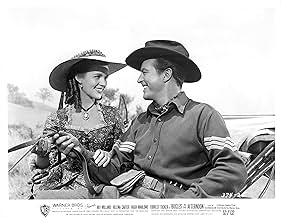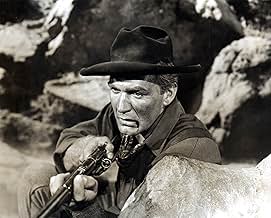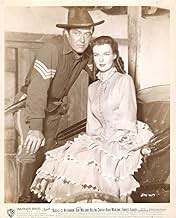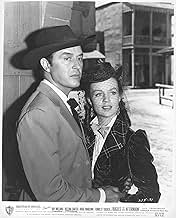After violently attacking a fellow officer Lt. Edward Garnett, cavalry Captain Kern Shafter is court martialled. Later, he rejoins the army with Custer's regiment at Fort Lincoln, Dakota, be... Read allAfter violently attacking a fellow officer Lt. Edward Garnett, cavalry Captain Kern Shafter is court martialled. Later, he rejoins the army with Custer's regiment at Fort Lincoln, Dakota, becoming a sergeant, where he runs into his old foe.After violently attacking a fellow officer Lt. Edward Garnett, cavalry Captain Kern Shafter is court martialled. Later, he rejoins the army with Custer's regiment at Fort Lincoln, Dakota, becoming a sergeant, where he runs into his old foe.
- Director
- Writers
- Stars
Mary Adams
- Woman
- (uncredited)
Carl Andre
- Trooper
- (uncredited)
Brandon Beach
- Telegrapher
- (uncredited)
Hugh Beaumont
- Lt. Cooke
- (uncredited)
Ray Bennett
- Minor Role
- (uncredited)
Rudy Bowman
- Trooper
- (uncredited)
Virginia Brissac
- Mrs. Carson
- (uncredited)
Bill Coontz
- Trooper
- (uncredited)
- Director
- Writers
- All cast & crew
- Production, box office & more at IMDbPro
Featured reviews
Surprised by the rather large production values displayed in this Ray Milland western. Big time film score by Dimitri Tiomkin, great cast of actors, nice sets and large cast of extras in pretty extravagant battle scenes between Calvary and Indians. While some reviews criticized the plot I found the love triangle main theme engaging and interesting and thought it dove tailed nicely with the epic canvas of the battle of the little big horn.
I enjoyed seeing George Reeves in a nice supporting role along with Barton McClain being cast as a good guy rather than his usual bad guy role. I particularly loved Forrest Tucker playing the role of an endearingly jovial Irish cavalryman. He steals the movie in many ways. I'm a fan of Ray Milland so I'm naturally going to like his trike in this film one of the best in the latter part of his career.
The movie is not "They Died With Their Boots On" but it is a well made big budget western for its time deserving to be seen and celebrated. Hope it comes out on a deluxe Blu-Ray I would buy it on day one!
I enjoyed seeing George Reeves in a nice supporting role along with Barton McClain being cast as a good guy rather than his usual bad guy role. I particularly loved Forrest Tucker playing the role of an endearingly jovial Irish cavalryman. He steals the movie in many ways. I'm a fan of Ray Milland so I'm naturally going to like his trike in this film one of the best in the latter part of his career.
The movie is not "They Died With Their Boots On" but it is a well made big budget western for its time deserving to be seen and celebrated. Hope it comes out on a deluxe Blu-Ray I would buy it on day one!
An interesting variation on the story of Custer's last stand. It deals with the same battle with the Sioux, but at a site a few miles away from where Custer and his men were massacred. This premise is a nice angle to focus on although I'm not sure that any part of this has any historical battle. The scenery is breathtaking and we were treated to arrows in the back, Indians flying off horses, hand to hand combat and fisticuffs between soldiers. Ray Milland looks alarmingly like John Wayne, but I enjoyed his performance. Too much of the movie concentrates on a love triangle between Milland, his boss and seemingly the only female in the whole area. Quite frankly, both men needed their heads banging together and told to get on with the job in hand. But where would the drama be in that? Despite this whole feud becoming a little tiresome, this was an interesting piece and is well worth a view.
Ray Milland looks rather too old and polished for the uniform of a cavalry sergeant, and it could have done with less of Dimitri Tiomkin's noisy score.
But the quirky framing employed in the prologue to this good-looking, action-packed Technicolor potboiler co.scripted by Geoffrey Homes (best known for his film noirs), which includes a bargain-basement reenactment of Little Big Horn, hints at the fanciful visuals of director Roy Rowland's very next film, 'The 5,000 Fingers of Dr. T'.
And it's always nice to see Barton MacLane play a good guy for a change.
But the quirky framing employed in the prologue to this good-looking, action-packed Technicolor potboiler co.scripted by Geoffrey Homes (best known for his film noirs), which includes a bargain-basement reenactment of Little Big Horn, hints at the fanciful visuals of director Roy Rowland's very next film, 'The 5,000 Fingers of Dr. T'.
And it's always nice to see Barton MacLane play a good guy for a change.
When the film begins, you see Captain Shafter (Ray Milland) being thrown out of the Cavalry for attacking another officer. The exact circumstances are unknown.
In the next scene, years have passed and Shafter is heading west on a stage coach. He is going to re-enlist in the Cavalry under an assumed name...and wouldn't you know it that the guy he attacked years ago (Hugh Marlow) is there and looking to get revenge on Shafter. All this, by the way, is set during the period in which Crazy Horse is on the rampage and heading to a showdown at the Little Big Horn.
This is a very standard western and Milland is just fine. There is nothing particularly bad nor good about this one...a decent time passer with a satisfying finale.
In the next scene, years have passed and Shafter is heading west on a stage coach. He is going to re-enlist in the Cavalry under an assumed name...and wouldn't you know it that the guy he attacked years ago (Hugh Marlow) is there and looking to get revenge on Shafter. All this, by the way, is set during the period in which Crazy Horse is on the rampage and heading to a showdown at the Little Big Horn.
This is a very standard western and Milland is just fine. There is nothing particularly bad nor good about this one...a decent time passer with a satisfying finale.
"Bugles in the Afternoon" was filmed in the desert around Kanab, Utah, and because of that arid landscape, many viewers may assume that Fort C.F. Smith and the Custer Battlefield were located somewhere in the American Southwest. Please keep in mind that the actual battlefield is located Southeast of Billings, Montana near what is now the border with Wyoming. The area along the Little Big Horn River, and eastward to the rise of Rose Bud Creek is characterized by rolling hills, which on that fateful morning of June 25, 1876 were probably still covered by green prairie grass, not rocks and sand. Though somewhat muddled geographically, this is still a most entertaining movie !
Did you know
- TriviaWhen Ray Milland's character views the aftermath of Custer's battle at the Little Big Horn through binoculars, footage from They Died with Their Boots On (1941)--also a Warner Bros. film--is used.
- GoofsObvious stunt doubles used in the fight between Shafter and Donavan and in the two fights between Shafter and Garnett.
- ConnectionsEdited from They Died with Their Boots On (1941)
- How long is Bugles in the Afternoon?Powered by Alexa
Details
- Runtime1 hour 25 minutes
- Aspect ratio
- 1.37 : 1
Contribute to this page
Suggest an edit or add missing content

Top Gap
By what name was Bugles in the Afternoon (1952) officially released in India in English?
Answer



































